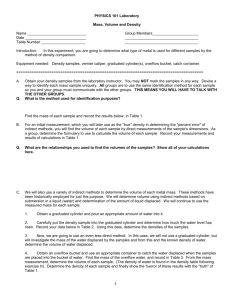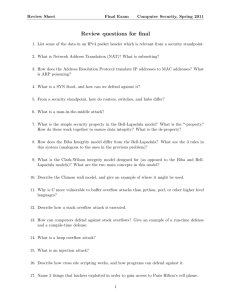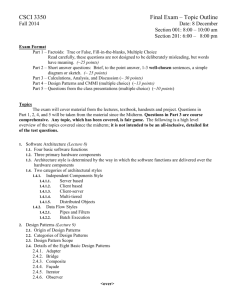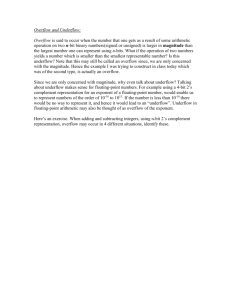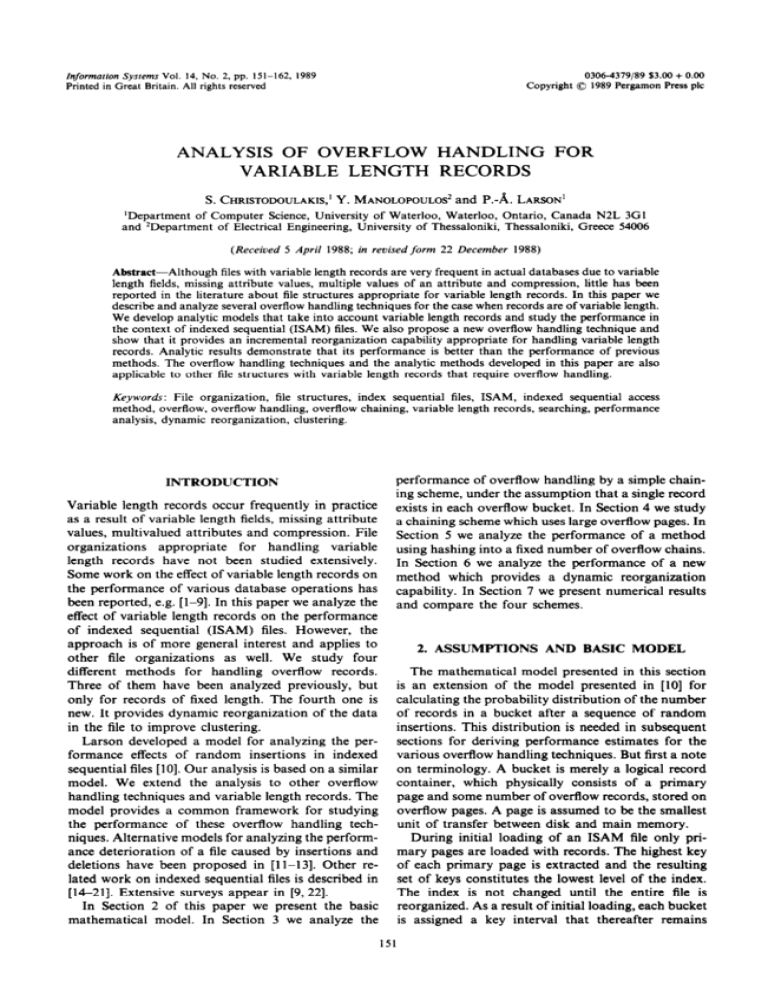
/n&mafion
,Symns Vol. 14, No. 2, pp. 151-162,
Printed in Great Britain. All rights reserved
1989
0306-4379/89
$3.00 + 0.00
Copyright 0 1989Pergamon Press plc
ANALYSIS OF OVERFLOW
VARIABLE LENGTH
HANDLING
RECORDS
FOR
S. CHRISTODOULAKIS,’Y. MANOLOPOULOS~and I’.-& LARSON’
‘Department of Computer Science, University of Waterloo, Waterloo, Ontario, Canada N2L 3Gl
and *Department of Electrical Engineering, University of Thessaloniki, Thessaloniki, Greece 54006
(Received
5 April 1988; in revised form 22 December
1988)
Abstract-Although
files with variable length records are very frequent in actual databases due to variable
length fields, missing attribute values, multiple values of an attribute and compression, little has been
reported in the literature about file structures appropriate for variable length records. In this paper we
describe and analyze several overflow handling techniques for the case when records are of variable length.
We develop analytic models that take into account variable length records and study the performance in
the context of indexed sequential (ISAM) files. We also propose a new overflow handling technique and
show that it provides an incremental reorganization capability appropriate for handling variable length
records. Analytic results demonstrate that its performance is better than the performance of previous
methods, The overflow handling techniques and the analytic methods developed in this paper are also
applicable to other file structures with variable length records that require overtlow handling.
Keywords: File organization, file structures, index sequential files, ISAM, indexed sequential access
method, overflow, overflow handling, overflow chaining, variable length records, searching, performance
analysis, dynamic reorganization, clustering
INTRODUCTION
Variable length records occur frequently in practice
as a result of variable length fields, missing attribute
values, multivalued attributes and compression. File
organizations
appropriate
for handling variable
length records have not been studied extensively.
Some work on the effect of variable length records on
the performance of various database operations has
been reported, e.g. [l-9]. In this paper we analyze the
effect of variable length records on the performance
of indexed sequential (ISAM) files. However, the
approach is of more general interest and applies to
other file organizations
as well. We study four
different methods for handling overflow records.
Three of them have been analyzed previously, but
only for records of fixed length. The fourth one is
new. It provides dynamic reorganization of the data
in the file to improve clustering.
Larson developed a model for analyzing the performance effects of random insertions in indexed
sequential files [IO]. Our analysis is based on a similar
model. We extend the analysis to other overflow
handling techniques and variable length records. The
model provides a common framework for studying
the performance of these overflow handling techniques. Alternative models for analyzing the performance deterioration of a file caused by insertions and
deletions have been proposed in [ll-131. Other related work on indexed sequential files is described in
[14-211. Extensive surveys appear in [9,22].
In Section 2 of this paper we present the basic
mathematical model. In Section 3 we analyze the
performance of overflow handling by a simple chaining scheme, under the assumption that a single record
exists in each overflow bucket. In Section 4 we study
a chaining scheme which uses large overflow pages. In
Section 5 we analyze the performance of a method
using hashing into a fixed number of overtlow chains.
In Section 6 we analyze the performance of a new
method which provides a dynamic reorganization
capability. In Section 7 we present numerical results
and compare the four schemes.
2. ASSUMPTIONS
AND BASIC MODEL
The mathematical model presented in this section
is an extension of the model presented in [lo] for
calculating the probability distribution of the number
of records in a bucket after a sequence of random
insertions. This distribution is needed in subsequent
sections for deriving performance estimates for the
various overflow handling techniques. But first a note
on terminology. A bucket is merely a logical record
container, which physically consists of a primary
page and some number of overtlow records, stored on
overflow pages. A page is assumed to be the smallest
unit of transfer between disk and main memory.
During initial loading of an ISAM file only primary pages are loaded with records. The highest key
of each primary page is extracted and the resulting
set of keys constitutes the lowest level of the index.
The index is not changed until the entire file is
reorganized. As a result of initial loading, each bucket
is assigned a key interval that thereafter remains
151
S. CHRISTOLWJLAKIS et al.
152
fixed. We assume that the keys of the records loaded
are a random sample from some underlying key
distribution. It was shown in [23] that the probability
mases Qi assigned to buckets i = 1,2, . . . , NB by this
procedure are identically distributed, random variables with mean E(Qi) = m/(M + 1) where m is the
number of records loaded in a bucket, M the total
number of records loaded and NB is the total number
of buckets in the file.
The exact distribution of the probability mass
assigned to a bucket and the correct distribution of
the number of records per bucket after a sequence of
random insertions were first derived by Batory [1 11.
The analysis in [lo] is based on an approximate
model. In the Appendix we present a different derivation which shows that the asymptotic distribution
is a negative binomidal distribution. Let a, a 2 0,
denote the file expansion factor, defined as N/M
where M is the total number of records originally
loaded and N is the total number of records inserted
thereafter. The probability that a bucket loaded with
m records contains n, n > m, records after the file has
expanded by a factor a is then asymptotically:
In our experiments we found that the performance
estimates obtained using the correct distribution are
considerably higher than those obtained by approximating the probability of insertion in a bucket by its
mean, as done in [lo]. The observed difference ranged
from 5 to 20%.
We are interested in the performance as a function
of the file expansion factor. The state of a bucket is
defined as the number of records x in the bucket
(x = m + n). If the buckets of the file were not
originally loaded with the same number of records,
the record distribution is given by:
P(x, a) = y
R,,, PI (x - m, a),
m=,
forx=m,m+l,...
(2)
where R, is the fraction of buckets that received m
records during loading and max is the maximum
number of records loaded in a bucket.
We assume that the population of records is
divided into L classes, C,, C,, . . . , C,, according to
length. Class C1 contains records with length I,, class
C, contains records with length lr, . . , and class C,
contains records with length I,. Without loss of
generality we assume that 1, < l2 c ’ . . < 1,. The
probability that a record belongs to class C, is pi,
i=l,2,...,
L and is assumed to be known. Record
lengths are assumed to be independent of primary key
values. The assumption of a fIxed number of classes
is motivated by the fact that varible length records
frequently are the result of missing attribute values,
repeated groups or storing records of a few different
types in the same file. If variable length records are
the result of variable length fields or compression the
length distribution is continuous and more difficult to
model. In this case the range of record lengths can be
subdivided into subranges and a class associated with
each subrange.
Consider a set of x records assigned to a bucket.
The probability that n, of these records have been
selected from class C,, n2 from C,, . . . , nL from C,
follows a multinominal distribution and hence is:
4(“,, . ..,%)=n.
,’
“!,. L!
x = X(a)
P(x, a)
p;2.
.p;‘.
(3)
The sum of the record lengths is
i
n, li.
i=l
Assume that b out of the x records are stored in the
primary page. Note that b is a random variable and
depends on the distribution of record lengths. Let
Q(b, x) be the probability that exactly b out of the x
records in a bucket are stored in the primary page.
Furthermore, let BS denote the number of bytes
available per primary page, PS the size of a pointer
in bytes and KS the size of a key in bytes (fixed).
These definitions are summarized in Table 1.
Table 1. Symbol definitions
Symbol
p;’
Definition
Number of records in a bucket (as a function of a)
Probability that a bucket contains x records when the file expansion factor equals u
X(a) Average number of records in a bucket (as a function of a)
b = b(a) Number of records in the primary page of a bucket (as a function of e)
Number of records initially loaded in a bucket
m
Number of records inserted into a bucket
Total number of records initially loaded in the file
ii
Total number of records inserted into the tile
N
BS
Size of a primary page (in bytes)
BSO Size of an overflow page (in bytes)
Key size (in bytes)
KS
Pointer size (in bytes)
PS
Number of classes of record lengths
L
Class i
ci
Record length of class i (in bytes)
4
Maximum number of records in a bucket
max
, nLrecords have length IL
q(n,, . . nr) Probability that n, records have length I,, ,
OCb. .xj
Probability that exactly b out of x records are stored in the orimaw owe of a bucket
Analysis of overflow handling
When computing the number of disk accesses for
record retrieval we consider only the extra access
required for retrieving overflow records, that is,
accesses over and beyond those required for traversing the index and for retrieving the primary page. The
cost of traversing the index depends on the structure
of the index, which is a separate issue.
3. ANALYSIS
OF SIMPLE
CHAINING
The expected number of records in the primary
page when the bucket contains x records can be
calculated as
The expected number of overfIow records is:
x b-1
In this section we analyze the performance of a
simple separate chaining scheme. In the scheme
overflow records are placed in a overflow area and
chained together. Each primary page has one
overflow chain which starts from the primary page,
not the index. Records in the primary page and
overIiow records are kept sorted according to key
values. The highest keys are placed on the overflow
chain. We assume a single record per page in the
overiIow area but a primary page may contain several
records. The motivation for a single record per page
in the overflow area is to make better use of main
memory and to reduce the page transfer time from
the disk to main memory. Note that if the proportion
of overflow records is small, then most of the buckets
have only one overflow record. If so, it is not justified
to use large overflow pages. This file implementation
is similar to IBM’s ISAM files. Separate changing
was also analyzed in [lo], but only for fixed-size
records.
The probability that exactly b records are stored on
the primary page when the bucket contains n records
is:
b Q(b, xl.
i
b-l
1 i
SEPARATE
153
611
]P(X)Q@, x) tx =;If-CP(X)
x
f
b-1
K?@,x~.
For large values of X (i.e. long overtlow chains), the
expected number of overflow records can be approximated by
A?-
b;,bQ@, xl.
P
This equation can be used to compare the expected
length of overflow chains for different record length
dist~butions. The expected space overhead can be
computed for the expected number of overtIow
records and the maximum record length.
We are now ready to compute the expected retrieval performance. Assuming, as in [lo], that every
record of the file has the same probability of being
retrieved, the expected number of additional access
for a successful search is given by:
x-1
f:
k=l
k(k + 1) Q(x -k, xl,
(5)
where R(a) is the expected number of records per
bucket,
r’(a) = i xP(x, a).
X=1
(4)
The above formula is explained as follows. Recall
that record lengths are independent of primary key
values. The ordering of the x records is determined
by their key values and does not change. However,
the length of a record is a random variable and
takes the value I, with probability pi, 1, with
probability pz, l2 with probability pz, and so on.
The first summation is over all combinations of b
records from L classes where the sum of the lengths
of the records is less than or equal to the size of a
primary page minus the pointer size. The probability
of such a combination is q(nl , . . . , n,), which is given
by (3). This condition guarantees that the b records
fit in the primary page. In order to have exactly 6
records in the primary page, the (6 + I)st record
must be longer than the empty space left in the page.
The probability of this event is given by the second
sum.
(f4
Recall that we consider only the extra access required
for retrieving overflow records. Formula (6) is
derived as follows. Q(.x - k, x) is the probability that
there are exactly x - k records in the primary page
and therefore exactly k overflow records. Assuming a
single record per overflow page, the expected number
of additionai accesses required to find a record is
k(k + 1)/(2x). The probability of accessing a bucket
which contains x records is xP(x, a)/_%‘(a).Formula
(6) follows after summation over k and x.
The expected number of additional accesses for an
unsuccessful search is given by:
j-l
x-l
x r: k(k+3)Q(x-k,x).
k-l
(7)
S. CHRIST~DOULAKIS ef al.
154
The formula is explained as follows. The x keys of a
bucket divide the key space of the bucket into x + 1
subintervals. We assume that a specified search key
belongs to any of these subintervals with the same
probability [23, IO]. A search for a key in the jth
subinterval is terminated when reaching the jth
record, j = 1,2, . . , x. A search for a key in the last
subinterval is terminated when the xth record has
been inspected. Thus, if there are k overflow records,
the expected number of additional accesses is
k(k + 3)/2(x + 1). This number of additional accesses has to be weighted by the probability
Q(x - k, x) of having k overflow records. The probability of an unsuccessful search hitting a bucket is
proportional to the number of records originally
loaded into the bucket, since this number determines
the probability mass from the underlying key distribution that was assigned to the bucket. Thus the
probability of hitting the bucket which was loaded
with m records originally is
max
Formula (5) follows.
The additional expected cost required for accessing
all the records of a bucket during a sequential scan
or range search is given by:
R(a) = f
P(x, a)
x=2
xf’kQ(x
-k, x).
k=l
(8)
The second sum in the above formula gives
the expected number of overflow pages, each one
holding a single record. This is also the expected
number of additional accesses required when the
bucket contains x records. It has to be weighted
by the probability that the bucket contains x
records.
The overflow space required per bucket is
given by:
SP(a) = BS, f
x=2
P(x, a) ‘i’ kQ(x - k, x),
(9)
k=l
where BS,, = 1, + PS is the size of an overflow page.
Each overflow page is of the same size and must be
large enough to hold a record of minimum length.
The second sum in the formula gives the expected
number of overflow pages required.
previous case, the search cost is thus reduced. In
addition, since overflow pages are large, variable
length records may be packed better within a page,
which improves the storage utilization and reduces
the search cost further. This file implementation is
well-suited for systems which use preformatted disks
(disks with fixed block size).
The probability distribution of the lengths of
records in an overflow page is not the same as in a
primary page. The reason is that longer records
have a higher probability of being intercepted by
the primary page boundary than shorter records.
Hence longer records are more likely to be found
in the overflow area. Let P;(t) be the probability of
all arrangements of records where a record of type Ci
is intercepted by the boundary of a primary page.
Then:
max
1 P(x,a)
P;(a)=
c
x=2
n,+"*+...+n‘<x
I.
L
1 n,l,6‘9-PS<li+,yl,~
-
1-I
x
q(n,,.
. .
,n,)*P,
for
i= l,...,
L.
This formula is derived in the same manner
as formula (4). It takes into account the fact that
the record with the next key value may not fit
in the primary page and therefore may have to
move into the overflow area. Any record with a
higher key value will then be in the overllow area as
well.
The probability that a record intercepted by a page
boundary is of type C, is:
Pjnt(a)=7.
P;(a)
I,
(10)
P,“(a)
To find the length distribution of records in the
overflow area we must consider both the intercepted
records and the remaining records on the overflow
chain (which follow the probability distribution Pi
i=l,...
, L). The fraction of intercepted records to
the total number of records in the overflow area is
given by:
NB c J’(x, a) 1 Q&x)
b<u
x=2
(11)
4. ANALYSIS OF CHANGING
USING LARGE OVERFLOW PAGES
In this section we analyze the performance when an
overtlow area with large pages is used. Overflow
records are placed on an overflow chain as in the
previous case, but now several overflow records from
different or the same bucket may be stored in the
same overflow page. We assume that an overflow
page that is examined remains in main memory so
that the same page does not have to be retrieved
more than once during a search. Compared with the
NB
5
W,
x-2
a)
c
b<x
(x
-
6)
QV, xl’
The enumerator is the expected number of buckets
having overflow chains (i.e. the expected number of
intercepted records), while the denominator is the
expected number of overtlow records. The proportion
of all other overtlow records is then:
l-
m XP2
c
x-2
p(x,a)
b<x
(12)
1
b<x
6
-6)
Q&x)
Analysis of overflow handling
Hence, the probability that the length of an overflow
record is 1, is given by:
155
The expected number of recors per overtlow page
is then:
P?(a) = (P:“‘(a) - Pi
(17)
f
x=2
X
f
r=2
P(x,a) 1 Q@, x)
b<x
W,
a)
c
b<x
+p,,
(x
-
6)
i=l,...,
The expected number of overflow pages containing
by [2]:
k overflow records can then be approximated
Q@, xl
L.
(13)
Since P?(u) is greater than Pi for long records,
will be greater than Pi for long records. The
reverse is true for short records. For large values
of a, the first term in the sum tends to zero and
Pp”(a) asymptotically approaches Pi. Figure 1 shows
the probability distribution P?(a) for two record
classes.
Given the length distribution of overflow records,
the number of overflow pages can be estimated.
The expected number of overflow records per bucket
is:
P?(a)
P(x, a$
N,,(a) = NB f
x=2
kQ(x -k,
x).
(14)
k=,
The expected number of pages in the overflow area is
then given by:
(‘5)
B(k)zNB.(.)*(1--sf)
(18)
where CL is the binomial coefficient, i choose k. Note,
however, that this formula overestimates the expected
page accesses [2].
Next we derive an estimate of the expected cost of
successful and unsuccessful searches when a simple
search algorithm is used for finding the qualifying
record. The algorithm simply follows the pointers of
the overflow chain until it finds the record or decides
that no record with the given key exists in the file.
Overflow pages retrieved from secondary storage
are assumed to remain in main memory so that a
page containing several overflow records from the
same bucket does not have to be retrieved more than
once.
The expected number of accesses for finding one of
the k overHow records is:
W) =; i
,-,
where
P(a)
B(r).
(19)
The expected number of accesses for an unsuccessful search when the length of the overflow chain is k
records is:
= i pp”(a)Z,
i=l
and 0 is the average number of bytes used in an
overflow page. 0 depends on how effectively the
overffow space is used. Assuming that a good algorithm is used for packing records into overflow
pages we can approximate 0 by:
o= B&-i.
(16)
L’(k) =&
,iI B(r) + B(k)).
(20)
The expected number of additional page access for
a successful search when using this overflow handling
technique is:
where I, is the length of the smallest record.
LARGE
IO-
P
E
R
C
E
N
T
A
G
E
OS-
‘Q.,
and the expected number of additional
for an unsuccessful search is:
OVERFLOW BUCKETS
Prmaly Pawa = Iwo
Page SIIC= 11a
l
Rl=SWB 4 PI=0 5
o RZ=lC@B & P’Z=O 5
*
.
.
max
U(a)=& 1
.
mk
jT,jRj"='
05 -
page access
ccc-f%(x, a)
x=2 x+1
x-l
x ,;, (k + 1) L’(k) Q<x -k
a). (22)
03 -
003
00
OS
1.0
I.5
20
The expected number of additional accesses per
bucket for a range search or a sequential scan is given
by:
FILE ECPANSION FACTOR
Fig. 1. Overflow distribution of records belonging to two
classes.
R(a) = i P(x, a)‘;i’
k-l
x-2
B(k) Q(x -k,
x).
(23)
The space per bucket required for overtlow records is
given by:
SP(a)=F(a)$
i
there are c chains). Using the binomial theorem [24],
the formula can be simplified to:
S(a) = &j
x=2
f P(x, a)ii:
x=2
k
x-l
x p(x, a) 1 kQ(x -k
X)
(24)
k-1
There are more efficient search algorithms (in terms
of page accesses) than those discussed above. For
example, if a key value between the values of the ith
and the rth record is found when the page containing
the ith record is retrieved, then the search can be
continued by following the chain emanating from
that record. An analysis of this type of algorithm is
considerably more complex. The expected cost of the
algorithms analyzed in this section is an upper bound
of the cost of this algorithm.
5. ANALYSIS OF CHAINING WITH
MULTIPLE CHAINS
In this section we analyze a chaining scheme which
uses several outflow chains per bucket. Denote the
number of chains per bucket by c, c > 1. Hashing is
used to determine to which one of the chains an
overflow record belongs. As in the case of separate
chaining, each overtlow page is assumed to store a
single record. Within each overflow chain records are
kept sorted according to key value.
The probability Q(b, x) that b records are stored in
the primary page when the bucket contains x records
can be calculated using equations (6) and (7). However, in equation (7), the constraints should take into
account the space requirements of the c pointers in
the primary page. That is, the space available in the
primary page for record storage is BS-cPS instead of
BS-PS.
The expected number of additional accesses for
successful search can be computed as:
S(a) = ~~~~P(x,a):~~Q(x-k,*)
This formula is derived in a similar way as formula
(5), except that the last summation takes into account
the fact that the k overflow records are distributed
among c chains. Assuming a uniform hashing function, each chain has a probability of l/c of receiving
an overtlow record. The probability that there are i
records on a particular chain is then
(25)
This formula is an approximation which does not
take into account the dependencies between chain
lengths. An expensive to compute, but exact formula,
can be derived using the multinomial distribution.
Note that assuming that each chain has the same
number of records, (k/c), would underestimate the
expected cost. For c = 1 the above formula reduces
to formula (5) which gives the expected cost when
using a single chain.
The expected number of additional accesses for an
unsuccessful search is given by:
y
U(a) = C
mR, XE2f$$$
2~jRim='
j=l
x-l
x c
k=l
QG-kx)C
k
i=L
k
i
1’
;
00
. (i + 3)
max
1
m G(x,x)
=p
c mR, c ~
x=2 x+1
2 km jRj m='
j-l
x-l
ak
(26)
k-l
This formula is derived in the same way as formula
(7). The last summation determines the total expected
cost of unsuccessful searches in a chain. This formula
reduces to formula (7) for c = 1.
The additional expected cost for accessing all
records in a bucket is given by:
R(a) = f
P(x, a) ‘i’ kQ(x -k,
x-2
x).
k-l
(27)
This is the same formula as (8). The only difference
is that the records must be sorted before being
returned to the user.
The additional space required per bucket is given
by:
Sp(a) = BS, f
x-2
The average cost of accessing these records is
i(i + 1)/2. The above formula follows by summing
over all values of i and multiplying by c (because
Q(x -k,x).
X
P(x, a) ‘f’ kQ(x - k, x).
(28)
k-l
This formula again is similar to (9) keeping in mind
that Q(x - k, x) is somewhat different, as discussed
in the begining of this section.
157
Analysis of overflow handling
6. ANALYSIS OF A METHOD USING A
LOCAL OVERFLOW DIRECTORY
In this section we analyze the performance of a new
overflow handling scheme. The basic idea is to have
on each primary page a small overflow directory
which stored the keys, record lengths and location of
all overflow records of the bucket. If a record is not
found in the primary page, the overflow directory
is searched to determine whether the record exists
as an overflow record. At most one additional
access is required to find any overflow record and no
additional accesses for an unsuccessful search. The
overflow records do not necessarily have higher key
values than the records in the primary page. Instead,
which records become overflow records is determined
by the record length. The smallest records are stored
in the primary page and larger records in the overflow
area. By keeping the smallest records in the primary
page more records will fit on the page. The fraction
of overflow records will be smaller and retrieval, on
average, faster. To achieve this, the class to which the
record belongs (or its length) must be indicated in the
overflow directory.
It may lx necessary to move a record from the
primary page to the overflow area to make room for
expanding the overflow directory. An entry in the
overflow directory of a primary page would typically
be much smaller than an actual record, even as much
as an order of magnitude smaller Thus it is highly
unlikely that a primary page would not have enough
space for the overflow directory. If this occurs the
problem can be solved either by reorganizing the file
or by using a flag indicating that the bucket is full and
a pointer to a second “primary page”. In the analysis
we ignore this case and assume that reorganization
takes place.
In this scheme the probability Q(b, x) that b
records are stored in the primary page when the
bucket contains x records is different from (5) because the length of records in the primary page is not
random. Instead, the smallest b records are placed
there. Let x records be selected, the b shortest of them
from the first j classes C,, . . . , C,. Let n,, . . . , nj,
where n, # 0 and
,$,
nJ =
b,
be such a combination
of b records. The remaining
x - b records have a length greater than or equal
to I,. Define C(j, b, x) to be the sum of the probabilities of selecting x records where the b smallest
are from the first j classes and the x -b records
from the classes C,, C,, ,, . . . , C,. Furthermore,
exactly b records must fit in the primary page.
Then
Q&x)=
i
j-l
cU,b,x).
The function C(j, b, x) is given by:
b!
c
Pi”’ . . .p;9
n,+“‘+“, n,!. . . n, !
Wb,x)=
where the summation
that
is over all combinations
such
f: nili<BS-(x-b)(KS+PS+LZ)
i-l
and where r > j is the minimum value that satisfies
nili>BS-(x-b-1)
/,-KS-PS-LI+i
i-2
(KS
+
PS + LZ).
LZ is the size of the record length indicator.
The above formula can be explained as follows.
The first b records are selected from classes Ci to
Cj while the last x - b records are selected from
classes C, to C, where r > j. This occurs with
probability
The b smallest records are distributed
classes with probability
b!
-pp;“’
n, ! . . . nj!
over the j
. . . pj”t
In this formula
Pf+.
1 Pk
k-l
The conditions stated guarantee that the next smallest
record, which is taken from class r, r > j, does not fit
into the primary page.
If r =j (i.e. nj records from class r are inside the
primary page and 1 records are outside) the function
C(j, b, x) is given by:
x-b
W
6
x)
=
c
I-0
1
n,+...+.,+/=b+/
“, # 0
X
4.
,...
(b + I)!
(n,+l)!P;““..P;“J+’
where the summation
that
is over all combinations
such
i~,n,r,<BS-(x-b)(KS+PS+U)
and
Given the function Q(b. x) the performance measures can be expressed as follows:
S(a) = &
U(a)
R(a)=
X$s R(x, a) ;i: kQ(x -k, x),
P
= 0,
f
(32)
P(x,a)‘i’kQ(x
x=2
S’(a)
(31)
-k,x),
(33)
k=I
= BS, t
P(x, a) ‘i’ kQ(x - k, x).
x=2
(34)
k=l
7. ~RICAL
RESULTS AND
COMPARISON
In this section we present numerical results computed using the formulae derived in the previous
sections. We use these results to compare the performance of the four methods considered, and to analyze the performance effects of variable length
records.
Figure 2 shows the expected number of disk accesses for a successful search as a function of the file
expansion factor. The primary page size for this
experiment was 4 kbytes. The records belonged to
two classes. The record size of the first class was kept
fixed at 400 bytes. The record size of the second class
was 400, 300 and 201 in three different experiments.
As expected, for the case of equiprobable classes, the
cost decreases as the size of the records of the second
class decreases. However, the cost reduction is not
linear. It is apparent from that figure that the cost
decreases more when the record length of the second
4
E
s
S
E
s
SIMPLE CHAININ G MODEL
SIMPLE CHAINING MODEL
5
A
c
G
class changes from 300 to 201 than when it changes
from 400 to 300 bytes.
The above observation is explained as follows.
There are two factors affecting the length of overflow
chains (and therefore the expected cost). The first is
the average record length. The smaller the average
record length, the more records are needed to fill a
primary page and therefore the lower is the expected
number of records on the overflow chain. The second
factor is the empty space left at the end of the primary
page (this is not always true but holds in general, e.g.
[9]). Intuitively, the larger the record size (relative to
the page size), the more space wilf be wasted at the
end of a primary page.
More wasted space implies longer overflow chains,
on average. If there were no empty space left at the
end of primary pages, then the distance between the
three curves in Fig. 2 would be the same. Since the
lowest average record length also implies less wasted
space at the end of primary pages, the distance of the
curves for R2 =201 and 300 is greater than the
distance for R2 = 400 and 300. In addition, as can be
seen from the figures, when the probability of the
class with the smallest record size increases the expected cost decreases. This is expected since both a
larger number of records can be packed in a primary
page and, at the same time, the average wasted space
in the primary page is reduced because of smaller
records.
Figure 3 shows a different experiment where the
average record length was kept constant at 250 bytes
for a block size of 500 bytes. As the variance of the
record lengths changed, the expected wasted space at
the end of the primary page changed, affecting the
length of overflow chains. The expected length of an
overflow chain for a large number of records per
bucket was derived in Section 2. Base on this analysis
it is easy to verify that the expected cost will be the
highest for R 2 = 300, followed by R 2 = 350,400 and
250. As the page size increases the wasted space at the
end of a primary page becomes small relative to the
page size. Thus the variance of the record length does
not significantly affect the performance. This is
shown in experimental results reported in [25].
3
0: RZ=3wB
&P2=0 :,
I R2=3mB&P2=09
+ R2=201B&PP=OS
~~R2=2OlBRP2=0.9
10
c,R1=3SOB
X.R1=3WB
+'Rl=%OB
2
1
00
0
00
05
IO
15
FILEEXPANSIONFACTOR
Fig. 2. Expected length of successful searches.
Z.0
00
05
10
15
FILEZEXPANSIONFACTOR
Fig. 3. Expected Iength of successful searches.
20
Analysis of overtlow handling
The performance figures for unsuccessful searches
are similar to those for successful searches. They are
not presented here but can be found in [25]. The cost
of range searches (or sequential scans) and the space
overhead increase linearly with the file expansion
factor [25]. Figure 4 shows the expected space overhead as a function of the file expansion factor.
Figure 5 shows the expected space overhead for the
case of records with R 1 + R2 = 500and BS = 500. In
this case the expected cost is highest for R2 = 400,
followed by R2 = 350, 300 and 250. This order is
different than the order based on the cost of successful searches. This is explained by the fact that the
storage cost depends on the maximum record length,
in addition to the length of the overflow chain, as was
analyzed in Section 1. This dependence is not eliminated as the size of the primary page increases
contrary to the cost of successful and unsuccessful
searches.
The performance figures for successful, unsuccessful and range search when using chaining with large
overflow pages are similar to those of simple chaining
[25]. The most significant advantage of this method
when records are of variable length is the reduced
amount of storage space required for overtlow
records. Figure 6 shows the expected storage overhead for this method.
The expected cost of successful searches is much
smaller when multiple chains are used, as shown in
Fig. 7. The expected cost of an unsuccessful search is
also much smaller than when using a single overflow
chain [25]. The overflow space requirements and the
range search cost are approximately the same.
Figure 8 shows the expected cost of a successful
search for the method using local overflow directories. The expected cost is much lower than for the
other techniques, especially for high values of the file
expansion factor. This is due to the fact that at most
one overflow page has to be read to tind a record. A
second observation from Fig. 8 is that, for equiprobable classes, the difference between the curves for
R2 = 400 and 300 is approximately the same as
the difference between the curves for R2 = 300
and 201. The reason is that, for large values of the
SIMPLE
CHAINING
SIMPLE
ew
MODEL
2w
0
00
10
05
15
FLE EXPANSION FACTOR
Fig. 5. Overflow space per bucket.
file expansion factor, a primary page is almost
always filled with the smallest records. This implies
little (and independent of the class) average wasted
space per page. On the other hand, the expected cost
of a successful search decreases as the probability
of the class with the smallest records increases.
The expected cost remains lower than for the other
methods.
For all the other methods analyzed the cost of a
succesful search is a convex function becoming
asymptotically linear for large number of overflows.
For the method using local overflow directories this
is not true. The first part of the function is convex but
the last part is concave. This is better shown in Fig. 9.
Asymptotically, the curve approaches an additional
cost equal to one. The cost of an unsucessful search
is always zero. The expected cost for retrieving all the
records in a bucket is shown in Fig. 10.
It is interesting to compare the storage overhead of
this method (Fig. 11) with that of chaining (Fig. 4).
In the case of a single record length, chaining has less
expected storage overhead than the overflow directory method. However, when there are several record
classes, the local overflow directory method may use
less storage space. The reason is that, since the
smallest records are stored in the primary page, it
utilizes better the space of overflow pages with longer
records. This also affects the range search cost since
all the pages of a particular bucket have to be
MODEL
soim ,
Page s,zc = 4KB
’ RI=R2=4WB
o R2=3008 & P2=0 5
x R2=3OOB & P2=0 9
B
Y
T
E
S
CHAINING
WITH
OVERFLOW
PAGES
,
Primary Pages = 1000
Page 31ze= 4KB
l
Rl=R2=4OOB
o R2=3008 $ P2=0 5
x RZ=SWB t P2=0 9
+ R2=101B & P2=0 5
# R2=20lB & P2=09
4coo
R2=201B & P2=0 9
CHAINING
P1=P2=05
’ RI=400B
o R1=350B
x Rl=SOOB
+ R1=250B
400
!
T
E
S
159
3030
2Om
0
00
05
IO
15
FLE RXF’ANSION FACTOR
Fig. 4. Overtlow space per bucket.
20
00
05
10
15
F,LE EXPANSION FACTOR
Fig. 6. Overtlow space per bucket.
20
160
S. CHlUsToD0ULaKls
el al.
CHAINING
2.0
WITH
MULTIPLE
CHAINS
LOCAL
12
Overlow
china = 3
l
15
o
x
+
#
A
C
C
E
s
s
E
s
10
Page sirs = 4KB
Rl-R2=4rnB
R2=300B & PZ=O 5
: R2=WJB & P2=0 9
R2=2OlB t PZ==O5
RZ=‘XOB k P2=0 9
Q-
l3-
0.5
S-
00
0
,
00
05
LO
I.5
20
FLE EXFANSION FACTOR
Fig. 7. Expected length of successful searches.
Fig. 10. Expected cost of retrieving all records of a bucket.
0.8
SOCK,
LOCAL
OVJZRFLOW
DIRECTORY
Page sire = 4KB
Key+Pointrr sne = 15B
’ Rl=R2=4mB
o R2=300B k P2=0.5
x R2-300B k P2=0 Q
0. R2=300B
k P2=0 5
x R2=300B k P2-0 Q
+ R2=201B k P2-0 5
# R2=201B k PZ=O Q
05
DIRECTORY
Page Lllze= IKB
Kev+Pomter si%o= 15B
’ :.Rl=R2=4mB
o R2-300B k P2=0 5
x R2=3mB k P2==09
+ R2=201B k P2=0 S
# R2-2018 k P2=0.9
FLE EXPANSION FACTOR
A
C
C
E
s
s
E
S
OVERFLOW
:
T
E
S
0.3
R2=201B k P2=0 9
00
00
0.5
10
15
20
FILE EXPANSION FACTOR
accessed (Fig. 10). The difference increases as the
variance between the record lengths increases.
As a final conclusion, when the variation in record
sizes is high, it appears that the overall performance
of the overflow directory method is superior to the
other methods analyzed, with the possible exception
of changing with larger overflow pages which may
require less space. A hybrid scheme combining the
overflow directory approach with the use of large
overflow pages may be the most cost effective solution. In addition to the reduced space requirements
of the overflow directory method, it may also reduce
the cost of range searches by clustering overflow
records into larger pages.
LOCAL
OVERFLOW
05
10
15
2.0
FL,?, EXPANSION FACTOR
Fig. 8. Expected length of successful searches.
0.0
00
DIRECTORY
Page s,re = 4KB
Key+Pomter size = 1SB
RI=lMXIBkPl=OS
R2=1mB k P2=0.5
04-
Fig. 11. Overtlow space per bucket.
8. CONCLUDING
REMARKS
In this paper we have studied several overtlowhandling techniques for variable length records and
derived analytic estimates of their performance. Our
formulae take into account the record length distribution of the underlying population of records. We
found that a new overflow handling method, the
overflow directory method, offers several advantages
over other methods. It allows for a gradual reorganization of the file so that the smallest records are kept
in the primary page, thus achieving better clustering.
The net result is a reduction in the expected search
lengths.
Future research involves the analysis of alternative
placement and search algorithms for variable length
records in an overflow area with large pages and
analysis of more efficient ways of searching overflow
chains. In addition, some approximation of the cost
equations presented is desirable to reduce the cost of
numerical computation.
REFERENCES
00
1.0
20
30
FILE EXPANSIONFACTOR
Fig. 9. Expected length of successful search.
[1] S. Christodoulakis. Estimating block transfers and join
sizes. Proc. ACM-SIGMOD-83
Conf. San Jose,
pp. 40-54 (1983).
[2] S. Christodoulakis. Implications of certain assumptions
in data base performance evaluation. ACM Trans.
Database Systems 9(2), 163-186 (1984).
Analysis of overflow handling
[3] G. Diehr and B. Faaland. Optimal pagination of
B-trees with variable-length items. Commun. ACM
27(3), 241-247 (1984).
[4] J. Hakola and A. Heiskanen. On the distribution of
wasted mace at the end of file blocks. BIT 20(2),
145-156 il980).
151 L. L. Larmore and D. S. Hirschberg. Efficient optimal
pagination of scrolls. Commun. ACM 28(8), 854-856
(1985).
161 E. M. McCreight. Pagination of B-trees with variablelenath records. Commun. ACM 20(9).
670-674
\
(1977).
]71 T. Montgomery. Designing magnetic tape files for
variable length records. Mgmr Informatics 3(6),
271-276 (1974).
181 J. L. Szwarcfiter. Optimal multiway search trees for
variable size keys. Acta Informutica 21(l), 47-60
(1984).
191G. Wienderhold. Database Design, 2nd edn. McGrawHill, New York (1983).
1101 P. A. Larson. Analysis of index-sequential files with
overflow chaining. ACM Trans. Database Systems 6(4),
I,
671-680
APPENDIX
Probability
Mass Assigned
to a Bucket
Consider an arbitrary but tixed bucket immediately after
initial loading. It is assumed that the keys loaded are
a random sample from the underlying key distribution.
Denote the cumulative key distribution by F(x). L.et the
keys assigned to the bucket under consideration be K,, , ,
The variables y, = F(Ki), i = 1,2,. . . ; M,
- K.,+m.
Kj+2,...,
are mutuallv indenendent and uniformly distributed in 10.11.
The total probability mass, that is, the probability that a
randomly selected key will be inserted into the bucket,
assigned to the bucket as a result of initial loading is then
Y - y. = F(K,+,) - F(K,). We therefore need the distri&&n oi the random variable x = yj+,,, - yj, where y, is the
lowest value obtained in sample of size M from the uniform
distribution, y, is the next higher value,.
, and y, is the
highest value obtained.
(1981).
[ill D. Batory. Optimal file designs and reorganization
points. ACM Trans. Database Systems 7(2), 60-81
(1982).
[I21 R. B. Cooper and M. K. Solomon. The average time
until bucket overflows. ACM Trans. Database Systems
9(3), 392-408
0
I
I
*I
=2
j-l
1
1
1
lM-j-m
m-l
(1984).
]131 D. P. Heyman. Mathematical models of database
degradation. ACM Trans. Database Systems 7(4),
615-631
161
(1982).
]141 J. A. Behymer, R. A. Ogilvie and A. G. Merten.
Analysis of indexed sequential and direct access file
organizations. Proc. ACM-SIGMOD
Workshop on
Data Description, Access and Control, pp. 389-417
(1974).
it51 B. K. Gairola and V. Rajaraman. A distributed index
sequential access method. Inform. Process Letts 5(l)
1-5 (1976).
]161 T. Leipala. On the design of one-level indexed sequential files. Int. .I. Comput. Inform. Sci. 10(3), 177-186
(1981).
1171T. Leipala. On optimal multilevel indexed sequential
files. Inform. Process. Letts 15(5), 191-195 (1982).
1181Y. Manolopoulos. Batched search of index sequential
files. Inform. Process. Lefts 22(5), 267-272 (1986).
[19] K. Maruyama and S. E. Smith. Optimal reorganization
of distributed space disk files. Commun. ACM 19(1I),
634-642 (1976).
1201 J. K. Mullin. ‘An improved index sequential access
method using hashed overflow. Commun. ACM 15(5),
We first need the joint probability P(y, = z,, y,+, = z2)
where z,, z2r [0, 1) and z, C z2. To have Yj= z, and
yj+m = z2, we must in the random sample have J - 1 values
less than z, , one value equal to z, , m - 1 values between z,
and z,, one value equal to z2, and the rest (M -j - m)
greater than z2 (see the above). The variable with value z,
can be chosen in M ways, the one having value z2, in M - 1
ways, the j - 1 variables less than z, in
ways, and the m - 1 variables between z, and z2, in
(“,-‘r
‘)
different ways. This gives the following probability:
JYY,
=
Zl,
Y,+m
=
52)
301-307 (1972).
]211 K. F. Wong and J. C. Strauss. An analysis of ISAM
performance improvement options. Mgmt Datamatics
4(3), 95-107 (1975).
1221 T. J. Teorey and J. P. Fry. Design of Database Structures. Prentice Hall, Englewood Cliffs, New Jersey
(1982).
[231 D. G. Keen and J. 0. Lacy. VSAM data design
parameters. IBM Systems J. 13(3), 186-212 (1974).
1241D. E. Knuth. The Art of Computer Programming.
Vol. I: Fundamental Algorithms, 2nd edn. AddisonWesley, Reading, Mass. (1973).
[251S. Christodoulakis, Y. Manolopoulos and P. A.
Larson. File organizations for variable length records.
Comouter Science Deoartment. Vniversitv of Waterloo,
1261W. Feller. An Introduction to Probability and its Appli-
Let K=M(M-l)(~~12)(M-jr1).
The probability that yj+, - yi = x is then obtained as:
p(Yj+, -yj=x)
I-x
=
~271T. Nakamura and T. Mizoguchi. An analysis of storage
utilization
in block split data structuring scheme.
Proc. VLDB-78 Conf. Berlin pp. 489-495 (1978).
I
P(Yj=zl~Y,+m=z~+x)~l
0
cations, Vol. 1, 3rd edn. Wiley, New York (1968).
I--x
=
K.p-’
z’I-‘(1 -z, - ~)~.-‘-~dz,.
S. CHRISTOWULAKIS
er al.
162
Now perform
which yields:
=Kxm-‘(1
the variable substitution
z, = r(1 -x)
We can find the asymptotic distribution by letting M,
N-+co, keeping M/N = a constant. From (2) we have:
I/_‘(1 - r)M-‘-“dt
-x)M-m
P,(n)=--
I’0
M(A4 - 1) (M - 2)!
(M -j
X
’
(M-m)!
(:I; >
x”-‘(1
-X)M-m.
Record distribution after insertions
The probability that n of the N records inserted hit the
bucket, given that it has been assigned a probability mass
of x, has a binomial distribution:
P(n Ix) =
N
0
n
x”(1 -x)N--“.
P(n ]x)P(x) dx
S’0
=$:I:)(:)
X
S’
~“(1 -x)~-“x~-‘(~
II
-x)“-mdx
by Mm+“,
m!n!
1(1-;)...(I-y)a(a-&)...(a--$)
’
(l+a)(l+a-k)...(l+a--v)
Letting m + co we finally obtain:
p+(na)=(m+n-ll)!
m
The probability that the bucket receives n out of the N
records is then:
P,(n) =
.
(M+N)(M+N-l)...(M+N-m-n+l)
m+n
After simplification we finally obtain:
-yj=x)=M
m!n!
Divide both the nominator and denominator
noting that M + N = M (1 + a). This gives:
m (m+n)!
(j-1)!(M-j-m)!x”-‘(1-~)~-”
p(Yj+m
(m+n)!
M(M-l)...(M-m+l)N(N-l)...(N-n+l)
- l)!
=(j-l)!(M-j-I)!‘@-l)!(M-j-m)!
m
m+n
(m - l)! n! (l+’
a”
(3)
The asymptotic distribution is simply a negative binomial
distribution with parameter p = l/(1 + a) [26]. The expected
number of records per bucket and its variance are therefore:
p =m +ma =m(l +ct), a*=m(l +a)a.
The fact that the asymptotic distribution is a negative
binomial gives an alternative way of looking at the problem.
Assume that we have an infinite supply of balls (records), of
which a fraction p = l/(1 + a) are labelled “old” and the
rest are labelled “new”. We randomly select balls until we
have m balls with label “old”. Then the probability of
having n balls with label “new”, for a total of m + n balls,
is exactly P: (n, a) above.
The probability distribution in [IO] was derived using the
expected value of the insertion probability mass assigned to
a bucket and ignoring the fact that it is a random variable.
This simplification leads to a poor approximation which
underestimates the number of overflow records. The correct
distribution was first derived in [1 I]. The first part of
the derivation above, up to equation (2), is based on the
same idea as the derivation in [ll]. The asymptotic
distribution given by equation (3) has not previously been
available.

